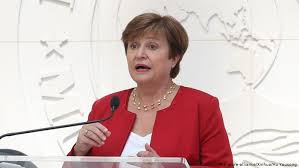The International Monetary Fund (IMF) on Tuesday raised its 2023 global growth estimates slightly higher as economic activity in the first quarter globally remained upbeat across geo-political regions worldwide.
It, however, noted that persistent challenges were dampening the medium-term outlook of the global economy.
The Breton Woods institution, in its latest World Economic Outlook, stated that inflation was moderating just as whirlwinds in the banking sector had receded, pointing out that the balance of risks facing the global economy remains tilted to the downside and credit was tight.
Specifically, the IMF projected that the global real GDP growth of 3.0% in 2023, up 0.2 percentage point from its April forecast, but left its outlook for 2024 unchanged, also at 3.0%.
Commenting on the report’s findings, IMF chief economist, Pierre-Olivier Gourinchas, said: “We’re on track, but we’re not out of the woods. What we are seeing when we look five years out is actually close to 3.0%, maybe a little bit above 3.0%. This is a significant slowdown compared to what we had pre-COVID.”
The IMF chief maintained that the slowdown was also related to the aging of the global population, especially in countries like China, Germany and Japan, adding that new technologies could boost productivity in coming years, but that in turn could be disruptive to labour markets.
The Washington D.C-based institution reported that outlook is “broadly stable” in emerging market and developing economies for 2023-2024, with growth of 4.0% expected in 2023 and 4.1% in 2024, noting that credit availability is tight and there is a risk that debt distress could spread to a wider group of economies.
It noted that the world was no better positioned now, noting the World Health Organization’s decision to end the global health emergency surrounding COVID-19, and with shipping costs and delivery times now back to pre-pandemic levels.
The IMF stated that “but forces that hindered growth in 2022 persist”, citing still-high inflation that was eroding household buying power, higher interest rates that have raised the cost of borrowing and tighter access to credit as a result of the banking strains that emerged in March.
It further clarified: “International trade and indicators of demand and production in manufacturing all point to further weakness”, noting that excess savings built up during the pandemic are declining in advanced economies, especially in the United States, implying “a slimmer buffer to protect against shocks.”
While immediate concerns about the health of the banking sector – which were more acute in April – had subsided, financial sector turbulence could resume as markets adjust to further tightening by central banks, it said.
The impact of higher interest rates was especially evident in poorer countries, driving debt costs higher and limiting room for priority investments. As a result, output losses compared with pre-pandemic forecasts remain large, especially for the world’s poorest nations, the IMF said.
The development finance institution also projected that global headline inflation would fall to 6.8% in 2023 from 8.7% in 2022, dropping to 5.2% in 2024, but that core inflation would decline more gradually, reaching 6.0% in 2023 from 6.5% in 2022 and easing to 4.7% in 2024.
Gourinchas said that it could take until the end of 2024 or early 2025 until inflation came down to central bankers’ targets and the current cycle of monetary tightening would end.
Also, the IMF raised concern that inflation could rise if the war in Ukraine intensified, citing concern about Russia’s withdrawal from the Black Sea grain initiative, or if more extreme temperature increases caused by the El Nino weather pattern pushed up commodity prices. That in turn could trigger further rate hikes.
It also noted that world trade growth was declining and will reach just 2.0% in 2023 before surging to 3.7% in 2024. The projected growth rates are well below the 5.2% clocked in 2022.
While raising its outlook for the United States,forecasting growth of 1.8% in 2023 compared to 1.6% in April as labour markets remained strong, the IMF left its forecast for growth in China, the world’s second-largest economy, unchanged at 5.2% in 2023 and 4.5% in 2024.
It slashed its growth outlook for Germany, which it now forecasts to contract 0.3% in 2023 compared to a 0.1% contraction in April, but sharply upgraded its forecast for the UK, which it projected now to grow 0.4% as against its 0.3% contraction forecast in April.
Euro zone countries are expected to grow 0.9% in 2023 and 1.5% in 2024, both up 0.1 percentage point from April.
Japan’s growth was also revised upward by 0.1 percentage point to 1.4% in 2023, but the IMF left its outlook for 2024 unchanged at 1.0%.
On the surging interest rate regime, the IMF advised central banks to remain focused on fighting inflation, strengthening financial supervision and risk monitoring, adding that if further strains appeared, countries should provide liquidity quickly, it said.
This is even as it advised countries to build fiscal buffers to gird for further shocks and ensure support for the most vulnerable.
Gourinchas further clarified: “We have to be very vigilant on the health of the financial sector … because we could have something that basically seizes up very quickly,” said. “There is always a risk that if financial conditions tighten, that can have a disproportionate effect on emerging market and developing economies.”
The IMF said unfavorable inflation data could trigger a sudden rise in market expectations regarding interest rates, which could further tighten financial conditions, putting stress on banks and nonbank institutions – especially those exposed to commercial real estate.
It warned: “Contagion effects are possible, and a flight to safety, with an attendant appreciation of reserve currencies, would trigger negative ripple effects for global trade and growth.”
Gourinchas said that fragmentation of the global economy given the war in Ukraine and other geopolitical tensions remained another key risk, especially for developing economies, adding that this could lead to more restrictions on trade, especially in strategic goods such as critical minerals, cross-border movements of capital, technology and workers, and international payments.
The 2023-2024 growth forecast remains weak by historical standards, well below the annual average of 3.8% seen in 2000-2019, largely due to weaker manufacturing in advanced economies, and it could stay at that level for years.




